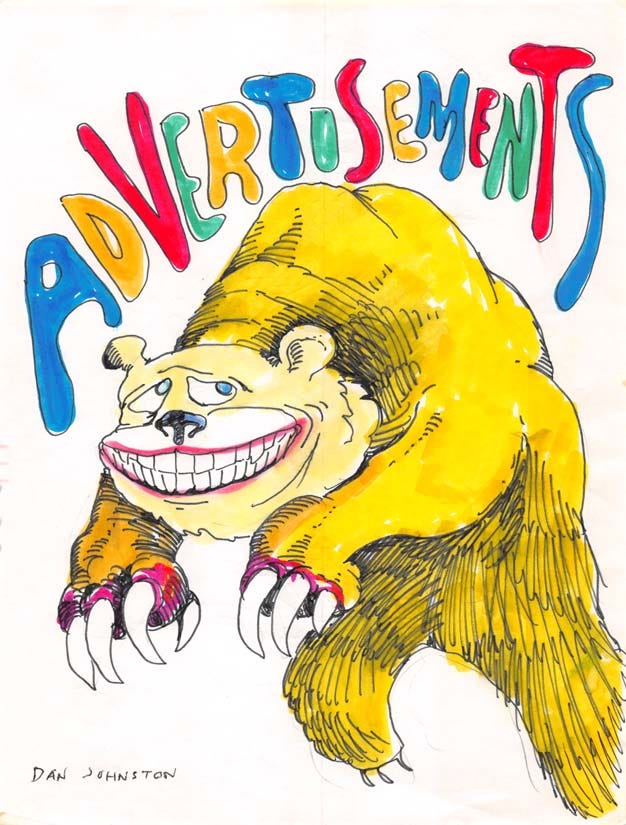This article was originally written and posted on my website. This is about 2 years old now, but I thought I’d re-release it to my now (slightly) larger audience. Thank you, and enjoy!
"Outsider art" is a term used to refer to a genre of otherwise un-characterizable artworks created by artists without formal training or connection to any established artistic tradition. Outsider artists and their artworks seem to erupt spontaneously without regard for contemporary tastes or external influences. They are usually created out of a great sense of internal drive. Placing definition onto the genre - that is, if it even ought to be called a genre - is to place undue rigidity onto the possibility of outsider art. Our definitions and understanding of art always references pre-established artists or former writers, whereas perhaps the defining feature of outside art is contained in its unconscious novelty.
Outsider art distinguishes itself from things like the Avant-Garde or "Anti-Art" movements in that the latter movements, although they are difficult to characterize, innovative, and certainly different, through their overt opposition and conscious inversion continue to reference the "powers that be" in the art world. Outsider artists seem simply unconscious, or rather lack self-consciousness in their expression. It is not enough that outsider art is simply "different", but rather that the artists are completely both outside of and unconscious of trend and popular thought in the art world.
Children's early artistic creations share many traits with those of outsider artists. Both are usually somewhat unconsciously created - "urged" out rather than planned - and lack reference to an established art world. Outsider artists, however, can undertake and pursue more ambitious projects than children can. They also are adults, and therefore have had more time to sharpen their technical skills.
Alongside or perhaps in part by their unrivaled spontaneity, and as evidenced in the parallels between children's artwork and their own, outsider artists are very often mentally ill - to the point where the term "outsider art" is sometimes erroneously understood simply as art made by the mentally ill. Certainly they share a great deal of overlap.
Innovations in disciplines usually come from two sources: from masters, who have thoroughly learned the rules of an established structure and can therefore tastefully break them at will, or from novices, who break rules without even knowing that they exist. Outsider artists, following the latter, combined with a high-energy, internally derived, passion, are a great source of artistic innovation.
Again, I stress that outsider art is much more easily defined by what it is not than by what it is. Their innovations are not found only within the confines of genre, but within genre itself - internally driven energetic commitment to particular borderless pursuits leads to creativity not only within content, but within media itself. It's not uncommon for outsider artists to have unique approaches regarding their media's packaging, distribution, advertising, creating, recording, publication, or performance.
I find it bizarre that there is a distinction between art and outsider art. Shan't, then, the dichotomy be equally expressed as "posers" and "artists"? We ought to celebrate the originality, bravery, and freedom that our so-called "outsider artists" possess, and appreciate their works seriously. Many "traditional" artists follow the "outside" in their own way: their truly unconscious, unblocked expressions are their highest quality or most popular works compared to their usual derivations. Unfortunately, especially in the lives of famous outsider artists, exposure leads to rapid dehumanization, where they are seen as a zoo animal or mere curiosity rather than a full human being. It is my hope to have contributed a positive image of the tenants of outsider art as a result of having written this article.
Read more:
These are some brief introductions to some interesting outsider artists. These little blurbs are just meant to give you an introduction to their work: deeper research of these individuals will always provide interest.
Daniel Johnston - Daniel Johnston is the most popular outsider artist. The bulk of Daniel's discography was recorded using whatever musical equipment was nearby. So, many of his recordings come from low-quality cassettes and feature detuned instruments. I personally appreciate Daniel Johnston for his visual artwork more than his music - he hand-drew most of his album artwork. Like nearly everyone on this list, the life of happenings of the artist are wide and wild; I can list everything here. For the music, I recommend "Never Relaxed" and the "Songs of Pain" album.
Terry A. Davis - Terry A. Davis was a computer programmer who, after experiencing what he described as a revelation from God, became to determined to create a temple to God in the form of a Christian operating system. He completed his goal, and there came his TempleOS and associated HolyC programming language. His work has been compared to a "one-man built skyscraper".





